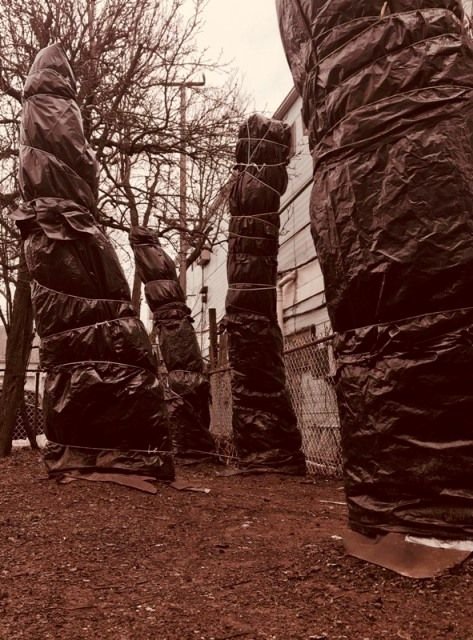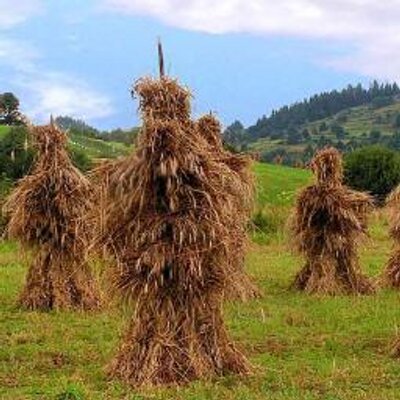Winterizing Fig Trees [plant hardiness zone 7]
Fig Tree (Συκιά)
To grow and maintain fig trees in harsher climates, that will continue to have fruit each season, they need to be winterized. When it's still small you can keep it in a pot and bring it indoors during the colder months. The best time to winterize is typically sometime in mid fall after all the leaves have fallen off the tree. If it starts getting cold early, before the leaves fall off, you can just cover them earlier. Most fig trees after about two-three years, at approximately 4’ (1.3m) tall, will begin to produce fruit. It won’t be much but enough that it becomes noticeable. Also it's probably a good time to plant them in the ground, if you haven't done so already. Now that the tree will be outdoors in the colder months as well, it needs to be wrapped and covered (winterized,) in order to prevent it from dying over the winter. Winterizing will help prevent the tree from freezing, which will reduce or eliminate its chances of bearing fruit again the next season If it freezes it will most likely die, or go barren for the next season or so. I've seen this happen to a tree that was about 15' (4.6m) tall and wide, because we didn't cover it one year. Causing it to have to be cut back to almost half its size... sad. There are probably different and perhaps even better ways to cover a fig tree. But the way I’m going to describe is how my father taught me and has been doing for over 30 years. It’s also how my grandfather did as well. In Greece fig trees wouldn't really need to get covered, due to the milder climate. So this method is just to describe what works in hardiness zone 7 based on actual experience. (quantity will vary depending on tree size) (average tree size: [medium] 10’ (3m) tall and wide) Starting from the bottom up, use the rope to gather the trunks and branches towards the center. Tying at several locations along the height of the tree works well, as opposed to wrapping up in a spiral. If you make a loop in one end of the rope, wrap it around the area you want to gather then slip the other end through the loop, you can use the rope like a lasso to gather that area tighter together. Take the roll of insulation, again starting from the bottom up and begin to wrap it around the base of the tree. As you wrap slightly move the roll up to spiral around the tree so that the insulation overlaps itself. Tie the insulation at the midpoint of each horizontal 'row' to help prevent it from slipping. Continue this until you've covered the whole height of the tree. Now with the roofing paper, using the same methods described in step 3 wrap the insulated tree. Here it's important to overlap the previous layer/row by about 6-10 inches (15-25cm) so that any moisture on the surface will drip over and down the paper and not enter the covering. As described in step 3 make sure that you tie the rows to keep them tight and prevent slipping. Take the garbage bag and cut the closed end so that both ends are open. Put the bag over the top of the tree and "thread" the tree through the bag, pulling it down to the base. Tie the bag in place. Continue until you've reached the top. Again making sure the new bag layers overlap, with the one on top always over or on the outside of the one below. Finally, take one bag that isn't cut and put the open end over the top of the tree like a sock. Pull it down as far as it goes and tie it to ensure it doesn't get blown off by the wind. Take the ground leaves and spread them around the base of the tree about 12 inches high, sloping down and outward away from the trunk. This will help insulated the base of the tree as snow and water tend to accumulate there. It will slowly decompose and fertilize the soil. If the leaves decompose or get blown away it's good to have a spare pile somewhere so that you can replenish as necessary.
"Common Fig"
source

Medium Sized Trees, "Winterized"
Potted trees, covered using the same method and kept outdoors.
Materials
Step 1 - tying the tree
Step 2 - insulating
Step 3 - protective cover
Step 4 - waterproofing
Step 5 - base insulation and fertilizer

FIGS!
Congratulations! This post has been added to our growing directory of Steemit post for the Homesteading/Survival communities. If you haven't done so already, you can claim your badge along with the code to add to your posts to let the world know you have chosen to help others Survive, Thrive and be Prepared! Click here to get the code
Thanks for stopping by, hopefully the info is relevant and helpful!
[Testing out the badge:]
Community Forums
Congrats!!!!!
oreos post!Sro xorio mou exoume sikies alla edo kai 4 xronia mas ta exei xalasei o xeimonas!
naiii eh? isos na tis skepasete opos emeis to kanoume edw. edw pou eimaste sthn ameriki pianei baris xeimonas k antexoune ama tis skepasoume kala!
That's so interesting. Reminds me of the ways people cover more sensitive plants such as roses in Polish villages:

Photo source
It has been so important in the rural culture that it is also included in one of our most important dramatic plays from the 19th century as a fantastic creature.
Beautiful figs. I can't wait until the spring so that I could sow some herbs and veggies on the roof. :)
are we sure those aren't American Snipers masquerading as fake bushmen
My first thought was that was were a lot of sci-fi writers get their ideas from. But I love it. Just goes to show how people can adapt to nature instead of expect nature to adapt to us.
not gonna lie when that image first caught my eye, i was wondering why @katayah was posting snipers in scarecrow camo
yup same concept!
roof gardening seems like a great idea!
Wow nice @hrissm
hey thanks for commenting but please read the article and post something constructive. otherwise just carry on!
thanks!
The day this kind of spamming stops! These people literally write scripts and bombs other peoples post. I wonder WHAT they expect out of it. Where do they think " This is a GREAT IDEA!!"